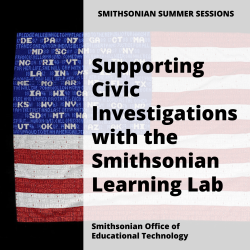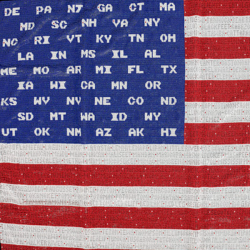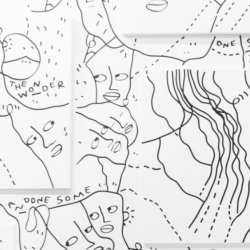Tess Porter
User Experience Strategist (she/her)
Smithsonian Office of Educational Technology
I'm the former User Experience Strategist at the Smithsonian Office of Educational Technology. Here, I focused on the use of digital museum resources to support teaching and learning. My work draws on my experience as a museum educator, digital analyst, usability researcher, and content designer. I hold a B.A. in Anthropology and a B.A. in Art History from University Colorado Boulder, and an M.S. in Museums and Digital Culture with an Advanced Certificate in User Experience from Pratt Institute.
Tess Porter's collections
Portrait Analysis: Lili'oukalani
<p>In this activity, students will analyze a portrait of Lili'oukalani (1838-1917), the last monarch of the Kingdom of Hawaii. Queen Lili'uokalani came to the throne after her brother's death in 1891 and ruled until 1893 when, to avoid bloodshed, she surrendered to a coup led by American business leaders. Opportunities to learn more include other portraits of Lili'uokalani, including one taken when she was 15, an article about her life and the annexation of Hawaii, and more.</p>
<p>This activity can be used as an entry point into studying Lili'uokalani's life and achievements, Hawaiian annexation, Hawaiian history and culture, and more. This activity opens with questions from the National Portrait Gallery's<em> "Reading" Portraiture Guide for Educators</em> and ends with a Project Zero Think / Puzzle / Explore routine; the full portraiture guide and routine instructions are located at the end of the collection.<br /></p>
<p><em>This Smithsonian Learning Lab collection received Federal support from the Asian Pacific American Initiatives Pool, administered by the Smithsonian Asian Pacific American Center.</em></p>
<p>Keywords: liliuokalani, hawai'i, polynesian, pacific islander</p>
<p>#APA2018 #BecauseOfHerStory</p>
 Tess Porter
Tess Porter
11
Flashcard Activity: Asian Pacific American Resources
<p>This collection contains a diverse set of resources related to Asian Pacific Americans that may be used as an introductory activity to spark classroom discussion and prompt students to conduct research about how Asian Pacific American history is American history. For discussion questions and activity implementation ideas, click "Read More." A file to print these resources as flashcards is located at the end of the collection; please see the resource's Information (i) tab for printing instructions.</p>
<p>This collection is not comprehensive but rather provides a launching point for further research and study.</p>
<p><em>This Smithsonian Learning Lab collection received Federal support from the Asian Pacific American Initiatives Pool, administered by the Smithsonian Asian Pacific American Center. </em></p>
<p>Keywords: printable, flash card, think puzzle explore, project zero visible thinking routine, apa</p>
<p>#APA2018</p>
 Tess Porter
Tess Porter
48
Flashcard Activity: Conflict, Identity, and Place in American Art
<p>This collection contains a selection of artworks related to the themes of conflict, identity, and place. They may be used for a variety of purposes; here, we use them as a catalyst for discussion. In small groups or as a classroom, have students select one artwork they find meaningful or interesting and discuss the following:</p>
<ol><li>Why did you pick this artwork? </li><li>What do you see? Name specific aspects of the artwork you notice.</li><li>What do you think about what you see?</li><li>What does this artwork make you wonder? </li><li><em>Optional</em>: How might the artwork connect to the themes of conflict, identity, and place?</li></ol>
<p>
</p>
<p>This activity works equally well online or using printed flashcards (see <a href="https://learninglab.si.edu/collections/flashcard-activity-conflict-identity-and-place-in-american-art/wCjeBXbgRgExR2Py#r/883001">the resource tile</a>). You may also replace or pair the above activity with a Project Zero Thinking Routine found in the final section of the collection. </p>
<p><em>This Smithsonian Learning Lab collection contains artwork selected by <a href="https://learninglab.si.edu/profile/666">Phoebe Hillemann</a>, Teacher Institutes Educator at the Smithsonian American Art Museum, to be featured in the 2018 Smithsonian American Art Museum Summer Institute for Teachers, "Teaching the Humanities through Art." The activity is adapted from Project Zero's See / Think / Wonder routine.</em></p>
<p>Keywords: printable, flash card, project zero visible thinking routine, New Jersey Principals and Supervisors Association, NJPSA, saam</p>
 Tess Porter
Tess Porter
51
Korean Art: Exploring Artistic Practices
<p>In this activity, students will explore the elements of art and principles of design used in celadon ceramics in order to understand the artistic practices and aesthetics of the Goryeo period (935-1392 CE), an era of great artistic and cultural achievement in Korea. Many of the Goryeo celadons in the Freer|Sackler's collections originally adorned palaces, Buddhist temples, and private residences of the aristocracy. Use this activity as an entry point into studying ceramics, Korean art, the Goryeo dynasty, and more. Click the info button<em> </em>for ideas about how to prompt further inquiry using the Project Zero Visible Thinking Routine <em>"</em>Think / Puzzle / Explore" and resources on the elements of art and principles of design.</p>
<p><a href="https://learninglab.si.edu/search?st=%23AsiaTeachers&st_op=and&item_type=collections" style="background-color:rgb(63,63,63);">#AsiaTeachers</a><br></p>
<p>Keywords: clay, pottery, sculpture, vessel, cheongja</p>
 Tess Porter
Tess Porter
13
Korean Ceramics: Looking at Decorative Processes
<p>In this activity, students will examine Korean ceramics and use visual evidence to speculate about the processes used to create them, paying special attention to decorative techniques. Questions from the Project Zero Artful Thinking Routine "Colors / Shapes / Lines," help students make detailed observations by drawing their attention to the forms in an artwork and giving them specific categories of things to look for. Use this activity as an entry point into studying ceramics or Korean art, or to student creation of artwork.</p>
<p><a href="https://learninglab.si.edu/search?st=%23AsiaTeachers&st_op=and&item_type=collections">#AsiaTeachers</a> </p>
<p>Keywords: pottery, observation, inlay, stamping, types, celadon, goryeo, clay, ceramic<br /></p>
 Tess Porter
Tess Porter
8
Woody Guthrie: Examining Portraiture
<p>This teacher's guide provides portraits and analysis questions to enrich students' examination of Woody Guthrie, one of the most important folk composers in American history. Includes the video "Defining Portraiture: How are portraits both fact and fiction?" and the National Portrait Gallery's "<em>Reading" Portraiture Guide for Educators, </em>both of which provide suggestions and questions for analyzing portraiture. Also includes multiple music recordings, a Smithsonian Magazine article about his legacy, and a podcast episode about his music and relationship with Smithsonian Folkways Recordings.</p>
<p>Consider:</p>
<ul><li>What do these portraits have in common? How are they different?</li><li>How are these portraits both fact and fiction?</li><li>How do these portraits reflect how he wanted to be seen, or how others wanted him to be seen? Consider for what purpose these portraits were created.</li><li>Having listened to his music, does the portrait capture your image of Woody Guthrie? Why, or why not?</li><li>If you were creating your own portrait of Guthrie, what characteristics would you emphasize, and why?</li></ul><p>Keywords: singer, musician, songwriter, oklahoma, protest, #SmithsonianMusic</p>
 Tess Porter
Tess Porter
12
Exploring Complexity: Westward the Course of Empire Takes Its Way
<p>In this activity, students will analyze an artwork that celebrates the idea of Manifest Destiny and western expansion - Emanuel Leutze's 1861 mural study for <em>Westward the Course of Empire Takes Its Way</em>, the final version of which rests in the U.S. Capitol Building. Through the use of two Project Zero Thinking routines - <em>What makes you say that?</em>, a Visible Thinking routine for interpretation and justification; and <em>Parts, Purposes, Complexities</em>, an Agency by Design routine for looking closely - students will consider what message this painting conveys, how choices made by the artist convey that message, as well as what perspectives are portrayed and what perspectives are missing. After looking critically, students will watch a video and learn from senior curator Richard Murray how to read this painting and what messages/images they may have missed.</p>
<p>This activity can be used as an entry point or supplement in studying westward expansion, the idea of Manifest Destiny, how public perspectives are shaped, and more. Resources to extend this activity include: a website about the final mural located in the U.S. Capitol Building and a Smithsonian American Art Museum lesson plan about both the mural study and the final mural.</p>
<p><em>Keywords: Emanuel Gottlieb Leutze, manifest destiny, westward expansion</em></p>
 Tess Porter
Tess Porter
7
What Makes You Say That?: Civil War Photograph
<p>Using the Project Zero Visible Thinking routine "What makes you say that?," students will investigate a photograph from the Civil War taken by the studio of Mathew Brady, one of the most prominent American photographers of the 19th century. The Civil War was the first major war captured on camera and photographs, like this one, played a pivotal role in shaping public perceptions of the conflict.</p>
<p>This activity can be used as an entry point into studying soldiers' experiences during the Civil War, photography's effect on public perspectives about war, and more. Resources to extend this activity include: a Smithsonian American Art Museum lesson plan investigating this and other photographs from the Civil War, a blog post discussing connections between Civil War photography and President Abraham Lincoln, a Smithsonian Magazine article about Civil War photographer Alexander Gardner, a Learning Lab collection on Alexander Gardner's <em>Photographic Sketchbook of the War, </em>and an article discussing the National Portrait Gallery's recent exhibition <em>The Face of Battle: Americans at War, 9/11 to Now</em>.</p>
<p><em>Keywords: photo, battlefield, inquiry strategy</em></p>
 Tess Porter
Tess Porter
8
Bracero Program: Step In, Step Out, Step Back
<p>In this activity, students will examine a painting of Mexican guest-workers, known as braceros, involved in the Bracero Program (1942-1964), the largest guest-worker program in US history. Started as a temporary war measure to address labor demands in agriculture and railroads, the program allowed Mexican nationals to take temporary agricultural work in Texas, New Mexico, Arizona, California, and 24 other states. By the time the program ended in 1964, over 4.6 million work contracts were awarded.
</p>
<p>Using a Project Zero Global Thinking Routine - "Step In - Step Out - Step Back" - students will examine the perspectives of those depicted in the painting, consider what it means to take the perspectives of others, and explore avenues and methods to learn more about Braceros. Resources for learning more about the Bracero program are located at the end of the collection and include: <em>Bittersweet Harvest</em>, a digital exhibition about the Bracero Program; the <em>Bracero History Archive</em>, which includes oral histories, objects, and more; and a Learning Lab collection of photographs documenting the Bracero Program.</p>
<p>Keywords: laborer, immigration, work, migration, migrant workers, agriculture, reform, politics, government, photojournalism, activity, inquiry strategy, global competency, global competence, latino, chicano, 1940s, 40s, 1950s, 50s, 1960s, 60s</p><p>#EthnicStudies</p>
 Tess Porter
Tess Porter
6
Community Building through Art
<p>This collection was created to accompany the live session <em>Cultivating Learning: Community Building through Art</em>, with guest elementary educator <a href="https://learninglab.si.edu/profile/eveeaton">Eveleen Eaton</a> from Sidwell Friends School, which focuses on transferrable techniques to use digital museum resources to nurture students’ abilities to explore ideas of community and actively participate in community building in your classroom. This collection includes digital museum resources and strategies to develop thoughtful interpretations, consider diverse perspectives, and explore identities in diverse learning environments discussed during the session. Ready-to-use activities explored during this session are appropriate for learners of all ages.</p>
<p>This session will air live on September 28, 2021 at 4:00 PM ET; <a href="https://www.youtube.com/watch?v=exO7SfTHZ88" target="_blank">click here to view on YouTube</a>. The archive will be added to this collection after it airs.</p>
<p>Keywords: project zero, thinking routine, chalk talk, see think me we, third grade teacher, arts as civic commons, edsitement<br></p>
 Tess Porter
Tess Porter
19
Supporting Civic Investigations with the Smithsonian Learning Lab
<p>Created to support the 2022 <em>Smithsonian Summer Sessions</em> workshop, “Supporting Civic Investigations with the Smithsonian Learning Lab,” this collection gathers resources and pedagogical approaches to investigate "the people" as a political concept with students. This collection is inspired by Educating for American Democracy's content theme, <a href="https://www.educatingforamericandemocracy.org/the-roadmap/7themes/#we-the-people" target="_blank">We the People</a>.</p>
<p>The 2022 <em></em><em>Smithsonian Summer Sessions: Inspiring Civic Engagement </em>is a virtual professional development opportunity. Held synchronously in late June 2022, it will be made available as a free, asynchronous virtual course in Fall 2022. </p>
<p>#SummerSessions</p>
 Tess Porter
Tess Porter
26
Investigating Tribal Sovereignty through Objects
<p>This collection was created to accompany the live session <em>Cultivating Learning: Investigating Tribal Sovereignty through Objects,</em> hosted with guest educator Renée Gokey from the <a href="https://americanindian.si.edu/" target="_blank">National Museum of the American Indian</a>, which focuses on transferrable, inquiry-based techniques to help students explore and understand tribal sovereignty through cultural objects. Tribal sovereignty is the authority of Native nations to self-govern, and it impacts how Native nations operate their own governmental systems, manage tribal lands, build economic strength, and facilitate complex relationships with local, state, and federal governments. This collection includes digital museum resources and standards-based approaches discussed during the session. </p>
<p>This session aired live on June 13, 2022 at 4:00 PM ET; <a href="https://www.youtube.com/watch?v=IX7k1_pWa00" target="_blank">click here to view on YouTube</a>. </p>
 Tess Porter
Tess Porter
30





